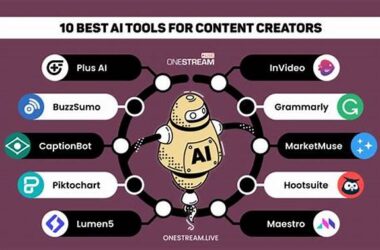- The Limitations of AI in Narration
- Striking the Balance: Human Creativity and AI Efficiency
- Discussion: The Nuances of AI in Creative Writing
- Examples: Is the Quality Low? The Unexpected Drawbacks of Using Basic AI for Complex Narrative Content!
- Understanding the Drawbacks
- Points of Consideration: Is the Quality Low? The Unexpected Drawbacks of Using Basic AI for Complex Narrative Content!
In a world where technology continuously shapes the way we live, work, and create, Artificial Intelligence (AI) has emerged as a powerful tool for many sectors. Its capacity to process vast amounts of data and generate content quickly makes it an appealing option for creators looking to produce narrative content efficiently. But before you start replacing your creative team with AI, there may be important limitations to consider. The question arises: is the quality low? The unexpected drawbacks of using basic AI for complex narrative content cannot be ignored if the aim is to craft engaging, unique stories that resonate with audiences on a deeper level.
Read More : Top Ai Tools Helping Influencers In 2025
AI tools, while exceptional in their capacity to handle repetitive tasks and offer some creative outputs, often lack the nuanced understanding of context, emotion, and human experience required for complex storytelling. As more writers and creators explore the potential of AI, it becomes vital to address the potential quality compromises that basic AI may introduce into intricate narratives. To highlight both the wonders and pitfalls of AI-driven storytelling, let’s explore the challenges faced when basic AI encounters complex creative tasks.
The Limitations of AI in Narration
Basic AI, while capable of generating vast amounts of content rapidly, can falter when tasked with creating narratives that require emotional depth and intricate character development. While it can string sentences together, the soul of storytelling often lies in the subtleties—metaphors, intricate dialogues, and profound insights—something machine learning algorithms frequently overlook.
Moreover, AI lacks personal experience and imagination, often leading to content that feels generic and uninspired. Relying solely on data patterns, basic AI can struggle to innovate or bring fresh perspectives that resonate with readers emotionally. Is the quality low? The unexpected drawbacks of using basic AI for complex narrative content become evident when storytelling feels mechanical and lacks the human touch essential for truly captivating tales.
Striking the Balance: Human Creativity and AI Efficiency
While AI can enhance productivity, its current limitations show that it is best utilized as a complementary tool alongside human creativity. Collaborating with AI can free up human creators to focus on the elements of storytelling that require a more personal touch. Writers and authors can utilize AI for data analysis, fact-checking, or generating plot ideas, while preserving the finesse and emotional authenticity that comes from human experience.
By acknowledging these drawbacks and strategically employing AI, content creators can leverage technology to enhance, not replace, human creativity. The ultimate fusion of human intuition with AI’s expansive capabilities could herald a new era of narrative content that is both innovative and deeply engaging.
—
Discussion: The Nuances of AI in Creative Writing
Understanding the Role of AI in Storytelling
The evolution of AI tools presents an interesting paradox for the creative industry. On the one hand, AI brings impressive efficiencies and capabilities that can revolutionize content production. On the other, the nuances of storytelling, often rooted in human emotion and cultural contexts, might be lost if we overly depend on these digital assistants.
The Potential Pitfalls
One of the major unsettling questions is the quality low? The unexpected drawbacks of using basic AI for complex narrative content remain a pressing issue. Without a deep understanding of human emotions, cultural nuances, or the ability to improvise, AI risks creating stories that fall flat. Rather than crafting a narrative with layered meaning and emotional resonance, AI-generated content may end up as archetypal and predictable.
AI-generated narratives can lack the subtlety that brings stories to life. Human readers connect with the hidden truths in storytelling, with characters’ grapples with life’s unpredictable nature, which AI currently cannot authentically replicate.
Humanizing AI’s Contribution
Interestingly, the sweet spot for AI use seems to be a hybrid model. AI can significantly contribute to brainstorming phases or initial drafts, while human writers refine the intricacies and tones needed for compelling storytelling.
The synergy between human creativity and AI productivity can potentially create narratives that are rich and deeply reflective of shared human experiences. Utilizing AI in this way allows writers to break free from mundane tasks and focus more on enriching the storytelling process.
Exploring Future Capacities
The fascinating aspect of AI’s role in creativity lies in its potential to evolve. Future AI capabilities might be able to mimic higher-level creativity elements as real-world experiences and emotions are encoded within their algorithms. However, even then, will the quality still be low? The unexpected drawbacks of using basic AI for complex narrative content spur vital discussion that will guide its future applications.
Crafting better AI tools means incorporating feedback loops and drawing insights from diverse datasets. This approach could help achieve narratives that are both technologically advanced and culturally resonant.
The Human Element
Ultimately, storytelling’s power lies in its ability to convey the intricacies of human experiences. It might be easier to rely on AI for factual and straightforward writing—like news articles—than on stories needing emotional depth and narrative creativity.
By nurturing a balance between man and machine, the creative industries can embark on a journey where AI acts less as a replacement and more as a creative companion. This could usher in a future where stories are more diverse, emotionally engaging, and uniquely reflective of our world.
—
Examples: Is the Quality Low? The Unexpected Drawbacks of Using Basic AI for Complex Narrative Content!
—
Understanding the Drawbacks
As AI technology continues to advance, its potential applications in narrative content creation seem boundless. However, with this evolution comes a crucial question: is the quality low? The unexpected drawbacks of using basic AI for complex narrative content are becoming increasingly evident.
Notably, AI-generated narratives can lack the emotional depth and contextual understanding that characterize human storytelling. While basic AI can generate text based on existing data, it lacks the ability to interpret human emotions and cultural nuances fully. As a result, AI outputs may beg the question—is the quality low? As intriguing as the AI advancements in storytelling may be, without the human touch, the content risks being mechanical and devoid of soul.
Furthermore, the over-reliance on AI-generated content raises concerns about creativity and originality. Unlike humans, who can draw from personal experiences and diverse perspectives, AI relies on patterns and existing data to craft narratives. This could lead to a saturation of monotonous and repetitive stories, lacking the innovative spark that human creativity brings.
Ultimately, while AI offers exciting prospects for the future of narrative content creation, its use must be approached with caution and supplemented by human intervention. The balance of AI efficiency and human creativity remains crucial to maintaining the quality and richness of storytelling. Striking this balance can drive the next phase of innovation in narrative content, where AI becomes a tool that enhances rather than hinders the creative process.
—



